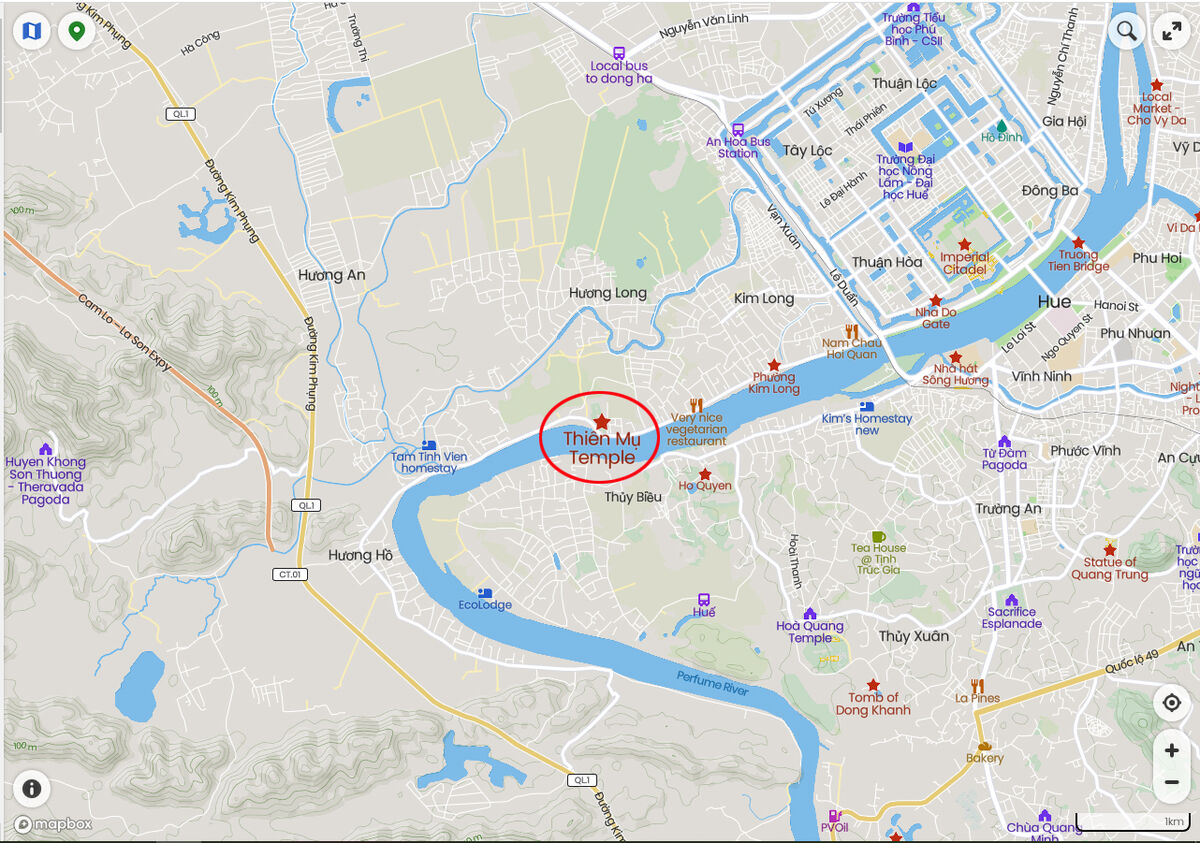Vietnam: Hue Part 5 - The Thien Mu Pagoda
Sep 19, 2022 14:45:08 #
After leaving The Citadel in Hue, we took a short cruise up the Perfume River to The Thien Mu Temple. Since it was late in the day, we only briefly toured the temple grounds.
The Thiên Mụ Temple (mean Temple of the Celestial Lady, Vietnamese: Chùa Thiên Mụ; also called Linh Mụ Temple) is a historic temple in the city of Huế in Vietnam. Its iconic seven-story Phước Duyên pagoda is regarded as the unofficial symbol of the city, and the temple has often been the subject of folk rhymes and ca dao about Huế.
The temple sits on the Hà Khê hill, in the ward of Hương Long in Huế. It is around 5 kilometres (3.1 mi) from the Citadel of Huế constructed by the Nguyễn Dynasty and sits on the northern bank of the Perfume River.
Built in 1601 on the order of the first Nguyễn lords, Nguyễn Hoàng, who at that time was the governor of Thuận Hóa (now known as Huế). The Nguyen Lords were in name, officials of the ruling Lê Dynasty in Hanoi, but was the de facto independent ruler of central Vietnam. According to the royal annals, Hoang while touring the vicinity, was told of the local legend in which an old lady, known as Thiên Mụ (literally "celestial lady"), dressed in red and blue sat at the site, rubbing her cheeks. She foretold that a lord would come and erect a pagoda on the hill to pray for the country's prosperity. She then vanished after making her prophecy. Upon hearing this, Hoang ordered the construction of a temple at the site, thus the beginning of Thiên Mụ Tự.
The original temple was simply constructed, then later expanded and refurbished. In 1665, major construction was undertaken by the Nguyễn Lord Nguyễn Phúc Tần.
In 1695, the Zen Master Shi Da Shan (Chinese: 釋大汕; pinyin: shìdàshān, or the Vietnamese transliteration "Thích Đại Sán"), a member of the Caodong school (Chinese: 曹洞宗; pinyin: cáodòngzōng, or the Vietnamese transliteration "Tào Động Tông"), arrived from China. He had been invited to come to Huế as a guest of the Nguyễn Lords to start a Buddhist congregation and oversee its development. He was a noted Buddhist scholar of the Qing Dynasty and was patronised by the ruling Lord Nguyễn Phúc Chu and was appointed as the abbot of the pagoda. In the seventh month of 1696, he returned to China, but conferred bodhisattva vows on Chu.
In 1710, Chu funded the casting of a giant bell, which weighs 3,285 kg, and was regarded as one of the most prized cultural relics of its time in Vietnam. The bell is said to be audible 10 kilometres (6.2 mi) away and has been the subject of many poems and songs, including one by Emperor Thiệu Trị of the Nguyễn Dynasty who ruled in the 1840s.
In 1714, Chu oversaw another series of major expansions and construction projects, the largest expansion phase in the pagoda's history. The main set of triple gates were erected, in addition to different shrines to the heavenly realms, the Ngọc Hoàng, the Thập Điện Diêm Vương (Chữ Hán: 十殿閻羅), halls for preaching dharma, towers for storing sutras, bell towers, drum towers, meditation halls and halls to venerate Avalokiteshvara and the Medicine Buddha and living quarters for the sangha.
Chu also organised for the staging of the vassana retreat which occurs annually between the full moon of the fourth and the seventh lunar month. The tradition had been inaugurated in the time of Gautama Buddha in ancient India to coincide in the rainy season. During this time, monks would stay in one place and pursue their spiritual activities, rather than wandering around and expounding the dharma to the populace, since they were prone to step on living beings during this time due to the water covering their paths. He also organised an expedition to China to bring back copies of the Tripitaka Canon and the Mahayana sutras, which comprised more than one thousand volumes, and interred them in the pagoda.
During the 19th century, the temple was patronised by the emperors of the Nguyễn Dynasty, which was founded in 1802 by Emperor Gia Long after his unification of modern Vietnam. His successor Minh Mạng funded further expansion and renovation of the temple.
Emperor Thiệu Trị, who succeeded Minh Mạng, erected the Từ Nhân Pagoda in 1844, which is now known as the Phước Duyên Pagoda. The brick pagoda stands 21 m and is of octagonal shape and has seven stories, each of which is dedicated to a different Buddha. The pagoda has stood there since, overlooking the Perfume River, and has become synonymous with the landscape of Huế and the Perfume River. Its impact is such that it has become the unofficial symbol of the city.
The temple also contains a statue of a large marble turtle, a symbol of longevity. Beside the tower on either side are structures that record the architectural history of the tower, as well as various poems composed by Thiệu Trị.
The temple and its buildings were severely damaged in a cyclone in 1904. Emperor Thanh Thai authorised reconstructions in 1907 and it has continued to the current day, although it was still substantially less grand and expansive as its halcyon days of the Nguyễn Dynasty before the storm. Today, a tourist facility is also present among the gardens and grounds of the temple, and a stupa has been erected in honour of Hòa Thượng Thích Ðôn Hậu, the abbot of the temple during its reconstruction phase in the 20th century. His holy body is entombed in the stupa, which is a garden of pine trees.
In the main hall, there is a statue of Maitreya Buddha, flanked by Bồ Tát Văn Thù Sư Lợi (Manjusri Bodhisattva) and Bồ Tát Phổ Hiền (Samantabhadra Bodhisattva).
During the summer of 1963, Thiên Mụ Temple, like many in South Vietnam, became a hotbed of anti-government protest. South Vietnam's Buddhist majority had long been discontented with the rule of President Ngo Dinh Diem since his rise to power in 1955. Diem had shown strong favouritism towards Catholics and discrimination against Buddhists in the army, public service and distribution of government aid. In the countryside, Catholics were de facto exempt from performing corvée labour and in some rural areas, Catholic priests led private armies against Buddhist villages. Discontent with Diem exploded into mass protest in Huế during the summer of 1963 when nine Buddhists died at the hand of Diệm's army and police on Vesak, the birthday of Gautama Buddha. In May 1963, a law against the flying of religious flags was selectively invoked; the Buddhist flag was banned from display on Vesak while the Vatican flag was displayed to celebrate the anniversary of the consecration of Archbishop Ngo Dinh Thuc, Diem's brother. The Buddhists defied the ban and a protest that began with a march starting from Từ Đàm Temple to the government broadcasting station was ended when government forces opened fire. As a result, Buddhist protests were held across the country and steadily grew in size, asking for the signing of a Joint Communique to end religious inequality. Thien Mu Pagoda was a major organising point for the Buddhist movement and was often the location of hunger strikes, barricades and protests.
In the early 1980s, a person was murdered near the pagoda and the site became the focal point of anti-communist protests, closing traffics around the Phú Xuân Bridge. The communist government responded by arresting monks on the charge of disturbing traffic flow and public order.
The temple also houses the Austin motor vehicle in which Thich Quang Duc was driven to his self-immolation in Saigon in 1963 against the Diem regime. It was the first of a series of self-immolations by members of the Buddhist clergy, which brought the plight of Buddhists to the attention of the international community.
https://en.wikipedia.org/wiki/Thi%C3%AAn_M%E1%BB%A5_Temple
For additional images of Hue, please see my previous posts:
https://www.uglyhedgehog.com/t-751475-1.html
https://www.uglyhedgehog.com/t-751760-1.html
https://www.uglyhedgehog.com/t-751941-1.html
https://www.uglyhedgehog.com/t-752098-1.html
I hope you enjoy these!
Mark
The Thiên Mụ Temple (mean Temple of the Celestial Lady, Vietnamese: Chùa Thiên Mụ; also called Linh Mụ Temple) is a historic temple in the city of Huế in Vietnam. Its iconic seven-story Phước Duyên pagoda is regarded as the unofficial symbol of the city, and the temple has often been the subject of folk rhymes and ca dao about Huế.
The temple sits on the Hà Khê hill, in the ward of Hương Long in Huế. It is around 5 kilometres (3.1 mi) from the Citadel of Huế constructed by the Nguyễn Dynasty and sits on the northern bank of the Perfume River.
Built in 1601 on the order of the first Nguyễn lords, Nguyễn Hoàng, who at that time was the governor of Thuận Hóa (now known as Huế). The Nguyen Lords were in name, officials of the ruling Lê Dynasty in Hanoi, but was the de facto independent ruler of central Vietnam. According to the royal annals, Hoang while touring the vicinity, was told of the local legend in which an old lady, known as Thiên Mụ (literally "celestial lady"), dressed in red and blue sat at the site, rubbing her cheeks. She foretold that a lord would come and erect a pagoda on the hill to pray for the country's prosperity. She then vanished after making her prophecy. Upon hearing this, Hoang ordered the construction of a temple at the site, thus the beginning of Thiên Mụ Tự.
The original temple was simply constructed, then later expanded and refurbished. In 1665, major construction was undertaken by the Nguyễn Lord Nguyễn Phúc Tần.
In 1695, the Zen Master Shi Da Shan (Chinese: 釋大汕; pinyin: shìdàshān, or the Vietnamese transliteration "Thích Đại Sán"), a member of the Caodong school (Chinese: 曹洞宗; pinyin: cáodòngzōng, or the Vietnamese transliteration "Tào Động Tông"), arrived from China. He had been invited to come to Huế as a guest of the Nguyễn Lords to start a Buddhist congregation and oversee its development. He was a noted Buddhist scholar of the Qing Dynasty and was patronised by the ruling Lord Nguyễn Phúc Chu and was appointed as the abbot of the pagoda. In the seventh month of 1696, he returned to China, but conferred bodhisattva vows on Chu.
In 1710, Chu funded the casting of a giant bell, which weighs 3,285 kg, and was regarded as one of the most prized cultural relics of its time in Vietnam. The bell is said to be audible 10 kilometres (6.2 mi) away and has been the subject of many poems and songs, including one by Emperor Thiệu Trị of the Nguyễn Dynasty who ruled in the 1840s.
In 1714, Chu oversaw another series of major expansions and construction projects, the largest expansion phase in the pagoda's history. The main set of triple gates were erected, in addition to different shrines to the heavenly realms, the Ngọc Hoàng, the Thập Điện Diêm Vương (Chữ Hán: 十殿閻羅), halls for preaching dharma, towers for storing sutras, bell towers, drum towers, meditation halls and halls to venerate Avalokiteshvara and the Medicine Buddha and living quarters for the sangha.
Chu also organised for the staging of the vassana retreat which occurs annually between the full moon of the fourth and the seventh lunar month. The tradition had been inaugurated in the time of Gautama Buddha in ancient India to coincide in the rainy season. During this time, monks would stay in one place and pursue their spiritual activities, rather than wandering around and expounding the dharma to the populace, since they were prone to step on living beings during this time due to the water covering their paths. He also organised an expedition to China to bring back copies of the Tripitaka Canon and the Mahayana sutras, which comprised more than one thousand volumes, and interred them in the pagoda.
During the 19th century, the temple was patronised by the emperors of the Nguyễn Dynasty, which was founded in 1802 by Emperor Gia Long after his unification of modern Vietnam. His successor Minh Mạng funded further expansion and renovation of the temple.
Emperor Thiệu Trị, who succeeded Minh Mạng, erected the Từ Nhân Pagoda in 1844, which is now known as the Phước Duyên Pagoda. The brick pagoda stands 21 m and is of octagonal shape and has seven stories, each of which is dedicated to a different Buddha. The pagoda has stood there since, overlooking the Perfume River, and has become synonymous with the landscape of Huế and the Perfume River. Its impact is such that it has become the unofficial symbol of the city.
The temple also contains a statue of a large marble turtle, a symbol of longevity. Beside the tower on either side are structures that record the architectural history of the tower, as well as various poems composed by Thiệu Trị.
The temple and its buildings were severely damaged in a cyclone in 1904. Emperor Thanh Thai authorised reconstructions in 1907 and it has continued to the current day, although it was still substantially less grand and expansive as its halcyon days of the Nguyễn Dynasty before the storm. Today, a tourist facility is also present among the gardens and grounds of the temple, and a stupa has been erected in honour of Hòa Thượng Thích Ðôn Hậu, the abbot of the temple during its reconstruction phase in the 20th century. His holy body is entombed in the stupa, which is a garden of pine trees.
In the main hall, there is a statue of Maitreya Buddha, flanked by Bồ Tát Văn Thù Sư Lợi (Manjusri Bodhisattva) and Bồ Tát Phổ Hiền (Samantabhadra Bodhisattva).
During the summer of 1963, Thiên Mụ Temple, like many in South Vietnam, became a hotbed of anti-government protest. South Vietnam's Buddhist majority had long been discontented with the rule of President Ngo Dinh Diem since his rise to power in 1955. Diem had shown strong favouritism towards Catholics and discrimination against Buddhists in the army, public service and distribution of government aid. In the countryside, Catholics were de facto exempt from performing corvée labour and in some rural areas, Catholic priests led private armies against Buddhist villages. Discontent with Diem exploded into mass protest in Huế during the summer of 1963 when nine Buddhists died at the hand of Diệm's army and police on Vesak, the birthday of Gautama Buddha. In May 1963, a law against the flying of religious flags was selectively invoked; the Buddhist flag was banned from display on Vesak while the Vatican flag was displayed to celebrate the anniversary of the consecration of Archbishop Ngo Dinh Thuc, Diem's brother. The Buddhists defied the ban and a protest that began with a march starting from Từ Đàm Temple to the government broadcasting station was ended when government forces opened fire. As a result, Buddhist protests were held across the country and steadily grew in size, asking for the signing of a Joint Communique to end religious inequality. Thien Mu Pagoda was a major organising point for the Buddhist movement and was often the location of hunger strikes, barricades and protests.
In the early 1980s, a person was murdered near the pagoda and the site became the focal point of anti-communist protests, closing traffics around the Phú Xuân Bridge. The communist government responded by arresting monks on the charge of disturbing traffic flow and public order.
The temple also houses the Austin motor vehicle in which Thich Quang Duc was driven to his self-immolation in Saigon in 1963 against the Diem regime. It was the first of a series of self-immolations by members of the Buddhist clergy, which brought the plight of Buddhists to the attention of the international community.
https://en.wikipedia.org/wiki/Thi%C3%AAn_M%E1%BB%A5_Temple
For additional images of Hue, please see my previous posts:
https://www.uglyhedgehog.com/t-751475-1.html
https://www.uglyhedgehog.com/t-751760-1.html
https://www.uglyhedgehog.com/t-751941-1.html
https://www.uglyhedgehog.com/t-752098-1.html
I hope you enjoy these!
Mark
Gail and our local guide at the entrance of the temple
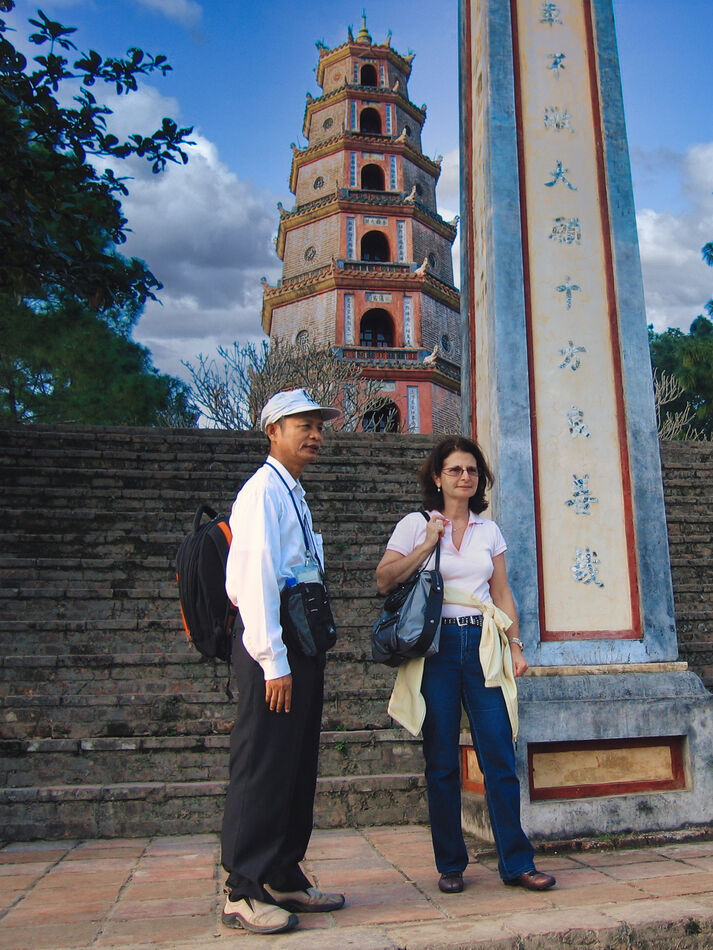
(Download)
Our Dragon Boat docked along The Perfume River below the Temple.\
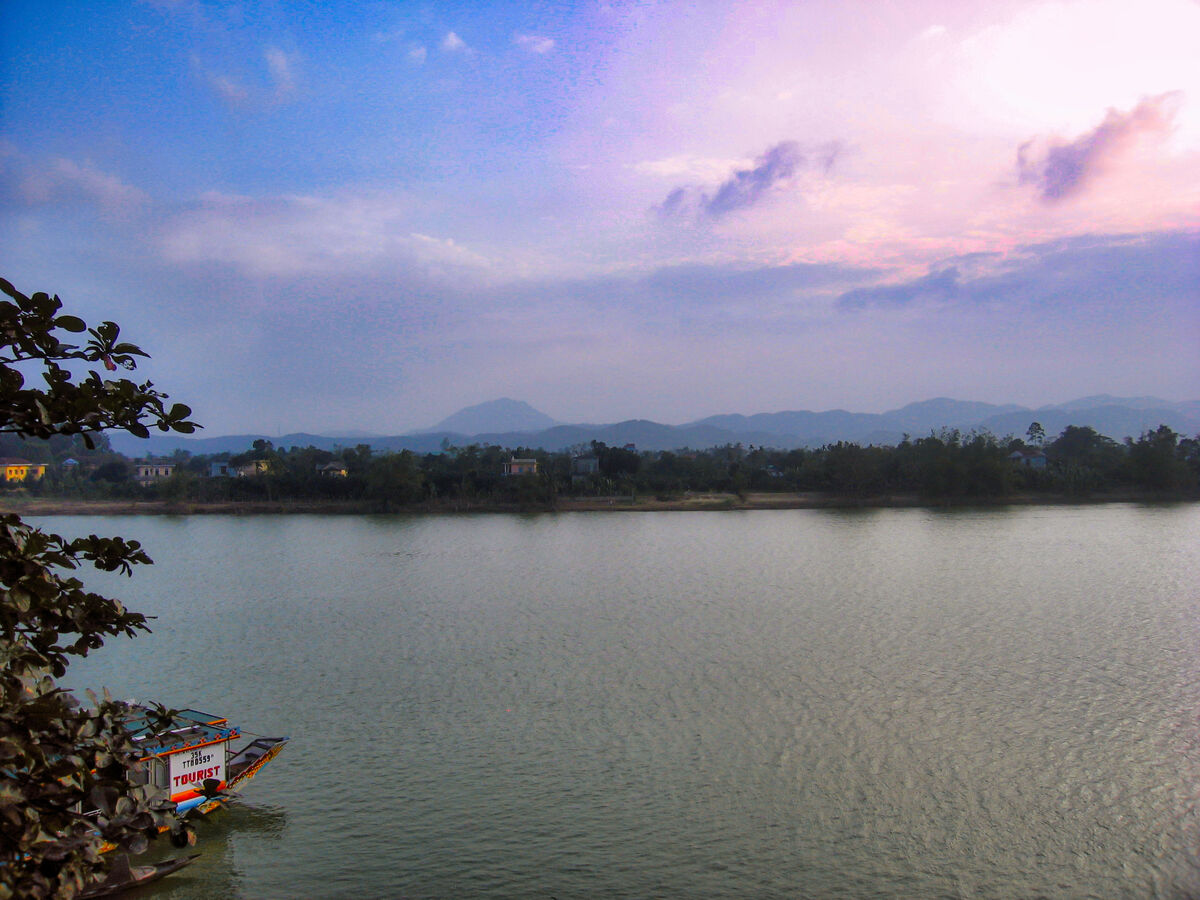
(Download)
Local kids love to get their picture taken!
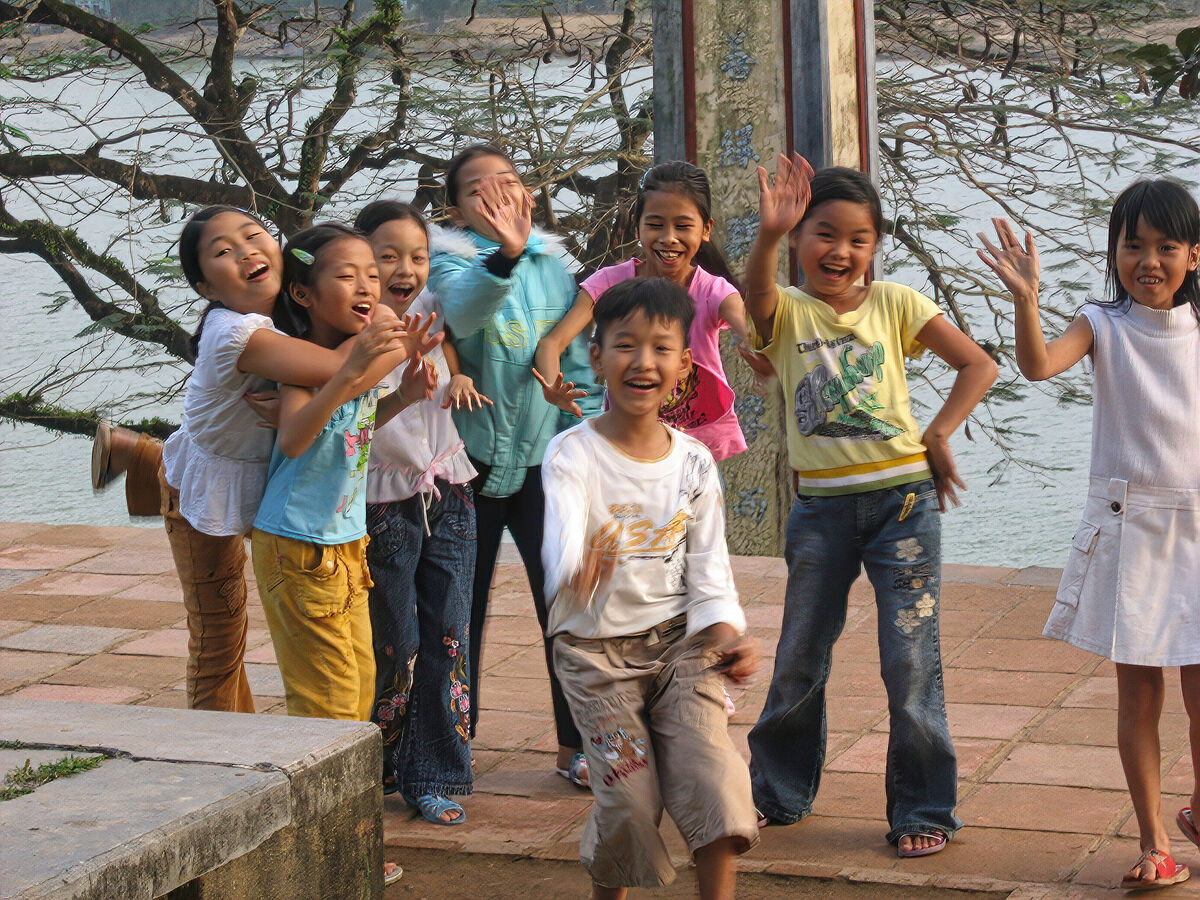
(Download)
Ringing the giant bell which was cast in 1710
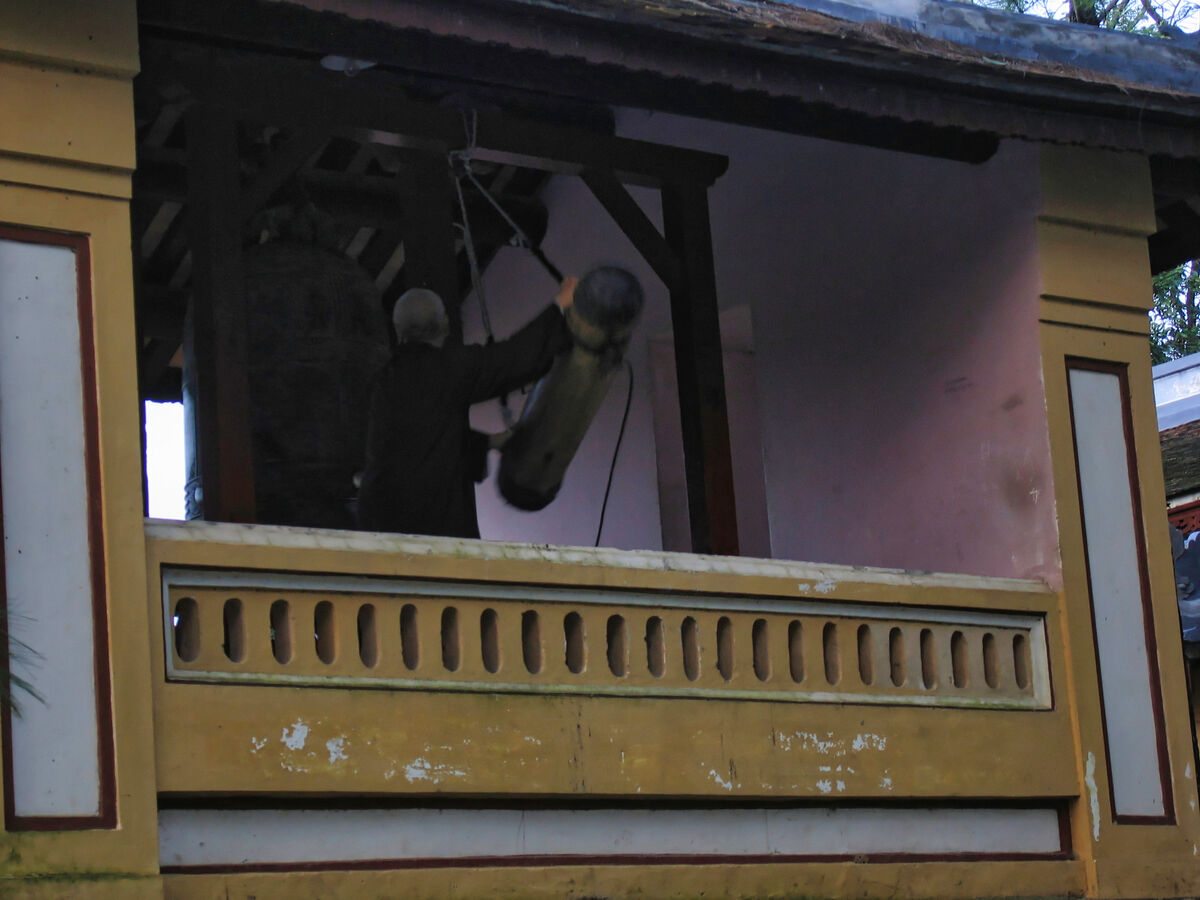
(Download)
Young Monks in Training play the "cat's cradle" game with rubber bands
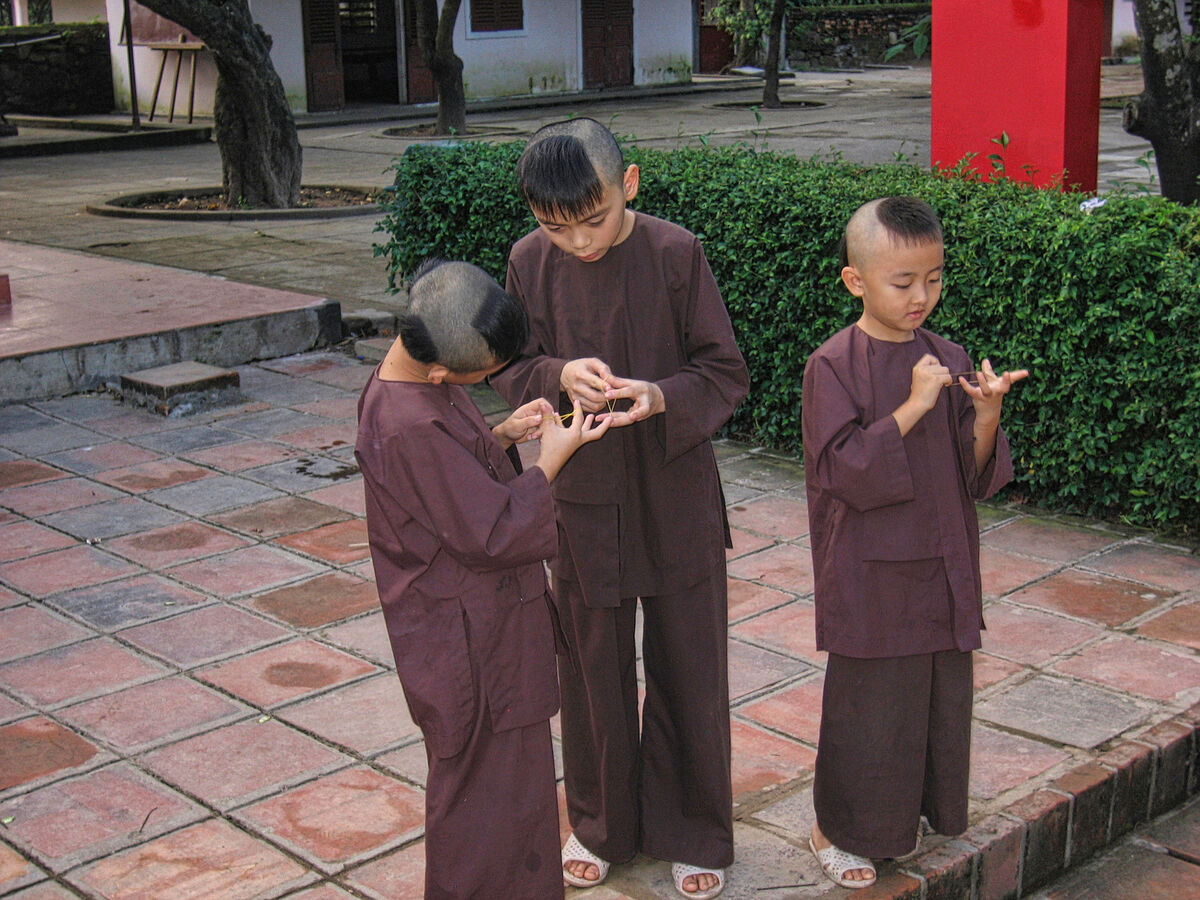
(Download)
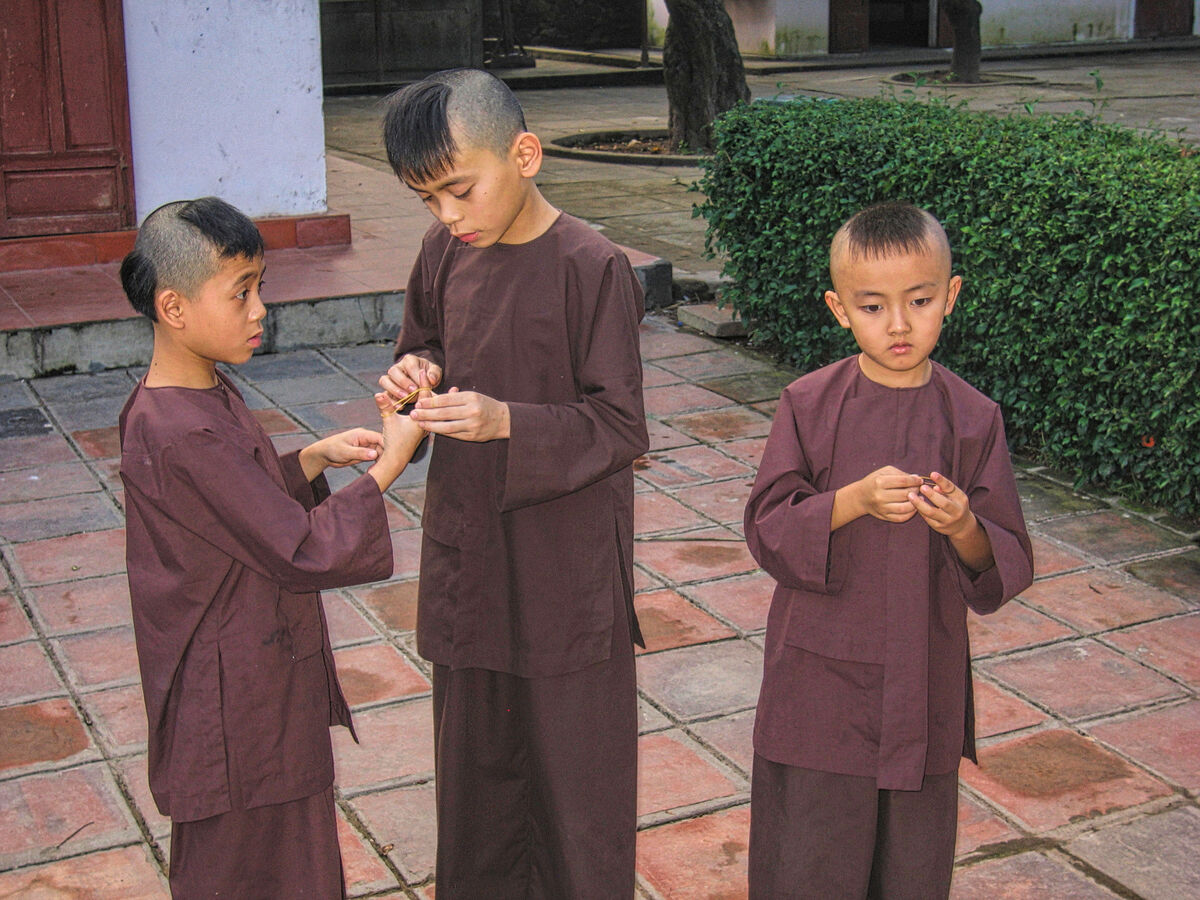
(Download)
The young monks in training serve the evening meal
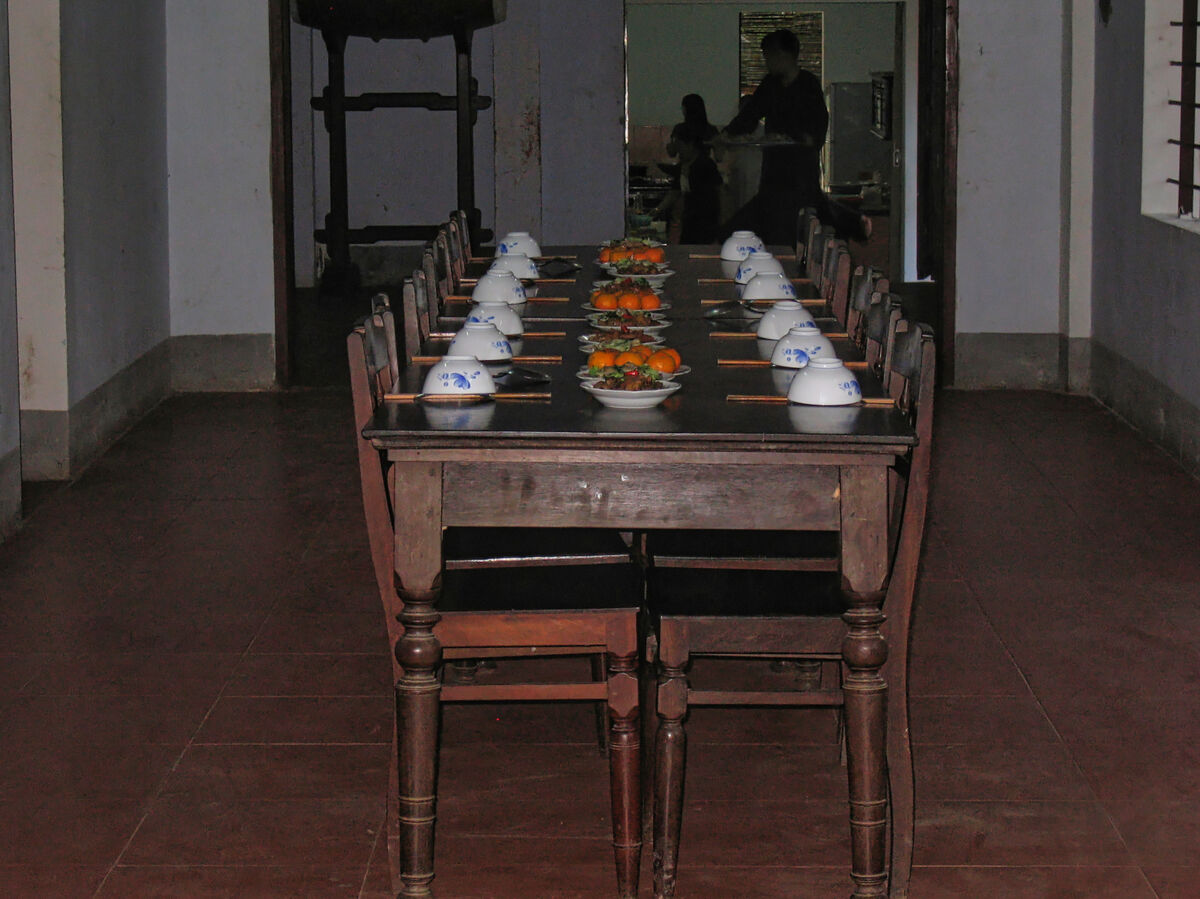
(Download)
Austin car in which Thich Quang Duc was driven to his self-immolation in Saigon in 1963 against the Diem regime.
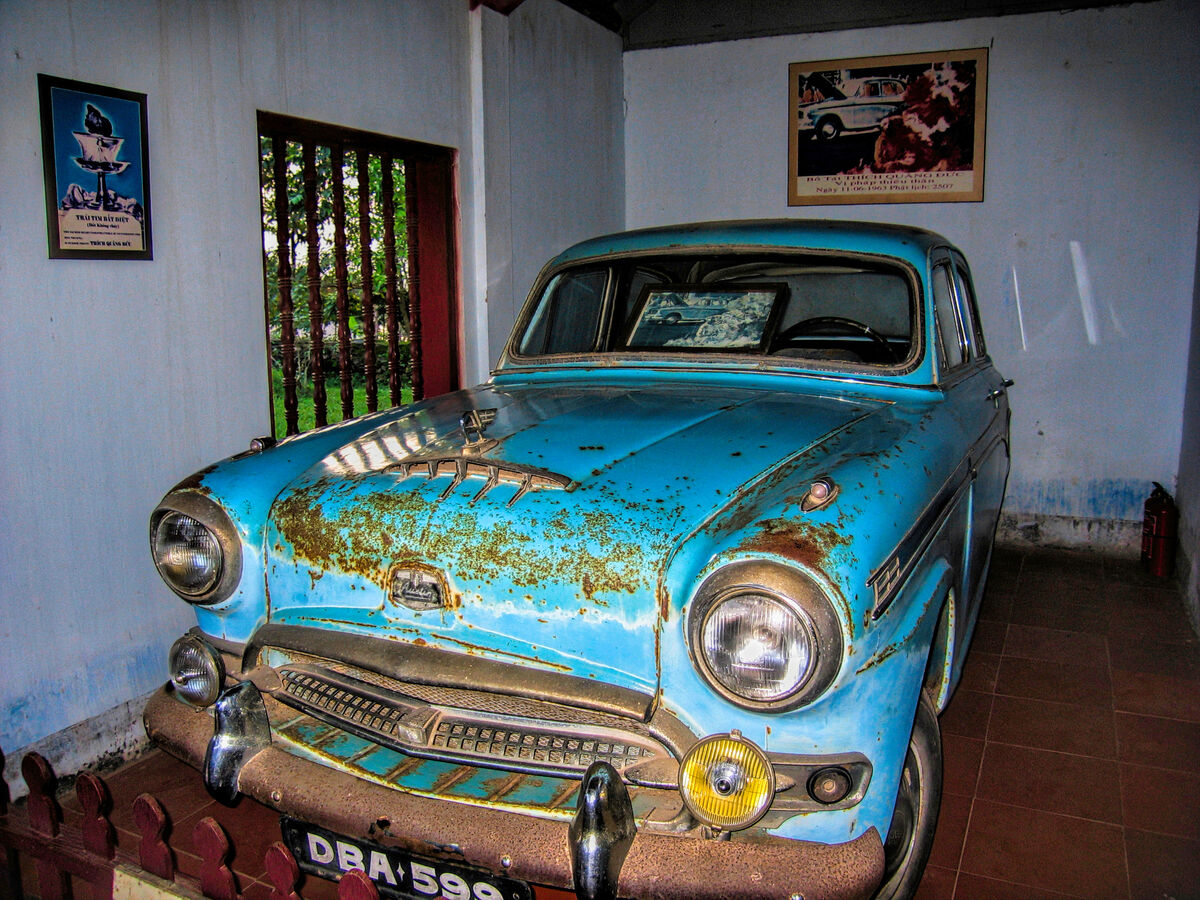
(Download)
Emperor Thiệu Trị, who succeeded Minh Mạng, erected the Từ Nhân Pagoda in 1844, which is now known as the Phước Duyên Pagoda.
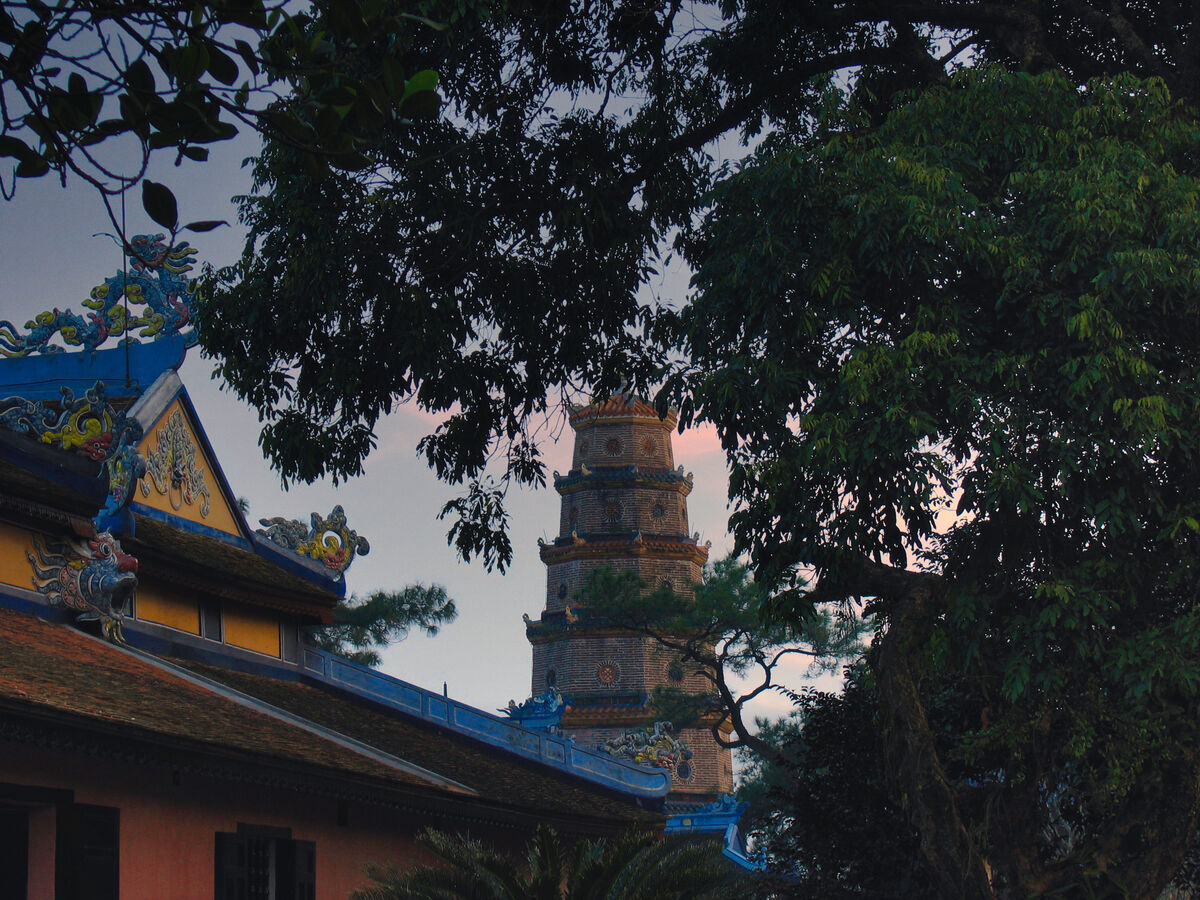
(Download)
Sun setting over The Perfume River as we departed
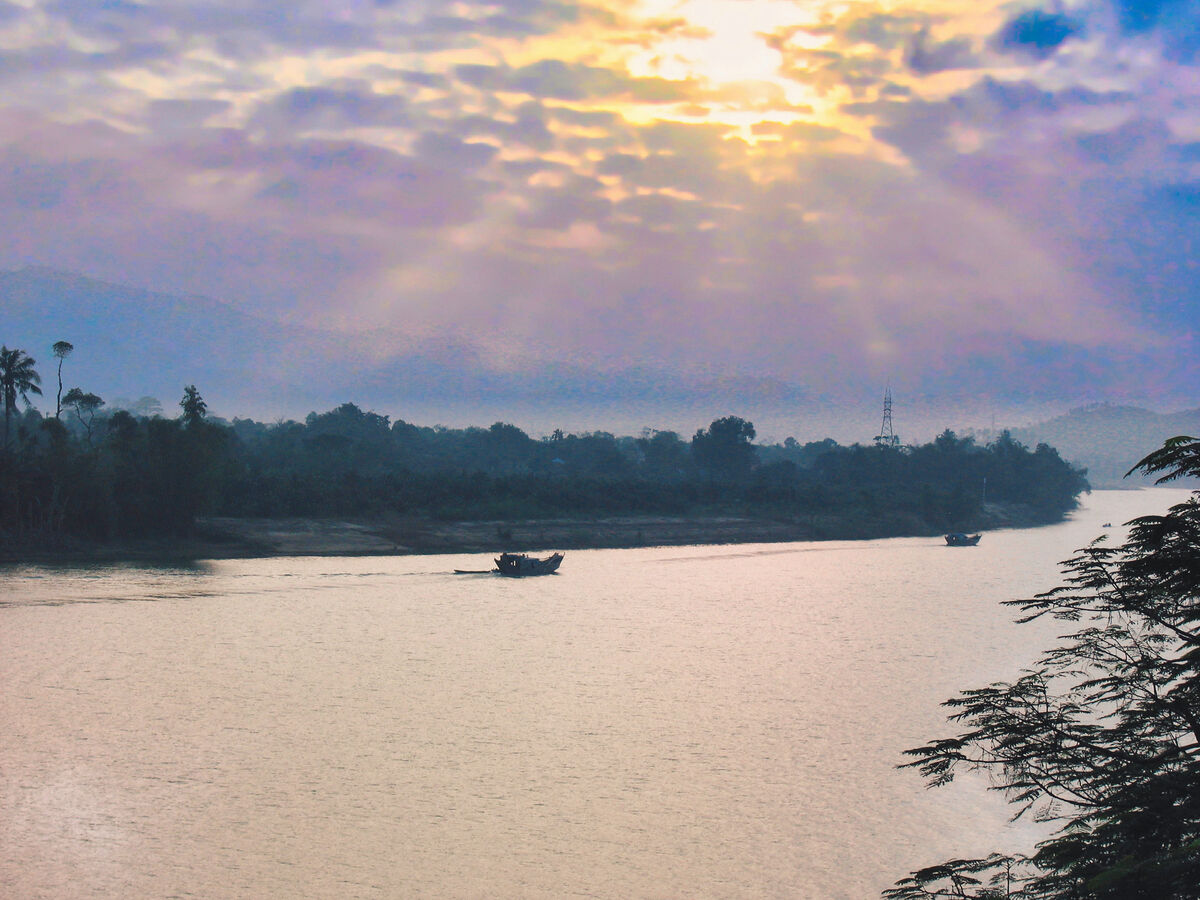
(Download)
Sep 19, 2022 14:45:53 #
Sep 19, 2022 15:20:38 #
Sep 19, 2022 15:23:15 #
UTMike wrote:
More of your beautiful tour with a great start, Mark!
Thanks very much Mike. We missed you!
Sep 19, 2022 15:24:50 #
Sep 19, 2022 15:26:40 #
Sep 19, 2022 15:33:00 #
Sep 19, 2022 15:33:10 #
srfmhg wrote:
Thanks very much Mike. We missed you!
Well, I missed Gail (LOL).
Sep 19, 2022 16:04:22 #
Sep 19, 2022 16:08:23 #
kpmac wrote:
An outstanding set with a great parting image, Mark.
Thanks very much Ken. I wish the camera had more resolution for that sky.
Sep 19, 2022 16:10:28 #
UTMike wrote:
Well, I missed Gail (LOL).
She appears prominently in the last few posts.
Sep 19, 2022 16:11:59 #
NMGal wrote:
Love the second and last for the soft colors. Still a very interesting tour.
Thanks very much Barbara. We had a great golden hour that day. More from the cruise back in my next post.
Sep 19, 2022 17:29:57 #
srfmhg wrote:
After leaving The Citadel in Hue, we took a short ... (show quote)
A great series Mark, one of your best. The last one is beautiful. Interesting narrative too.
Sep 19, 2022 17:55:21 #
DJphoto wrote:
A great series Mark, one of your best. The last one is beautiful. Interesting narrative too.
Thanks very much Dennis.i wish I had my D7500 for that scene!
Sep 19, 2022 18:04:46 #
srfmhg wrote:
Thanks very much Dennis.i wish I had my D7500 for that scene!
I know what you mean. I guess you'll have to go back and re-shoot everything. I feel the same about some previous trips; I need to go back to the Canadian Rockies and Glacier National Park with my Canon 90D, which we hope to do.
If you want to reply, then register here. Registration is free and your account is created instantly, so you can post right away.

